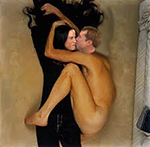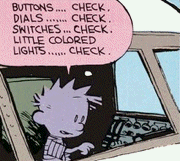|
Fats posted:Is there anything inherently dangerous about split-bus panels? The house I'm closing on in a couple weeks has one (I-T-E brand). Service is 150A (2/0 aluminum), and everything here is already electric, so I can't imagine needing to upgrade that. Wiring is NM-B, but I don't think NM-B was around in 78 when the house was built, so I guess that was replaced. There are even a couple of empty breaker slots. Upgrading your light and outlet breakers to arc fault is an excellent idea. With the bonus that you might even be able to lower your home owners insurance.
|
|
|
|

|
| # ? May 17, 2024 16:45 |
|
Fats posted:Is there anything inherently dangerous about split-bus panels? The house I'm closing on in a couple weeks has one (I-T-E brand). Service is 150A (2/0 aluminum), and everything here is already electric, so I can't imagine needing to upgrade that. Wiring is NM-B, but I don't think NM-B was around in 78 when the house was built, so I guess that was replaced. There are even a couple of empty breaker slots. Uhh, NM goes back to the 1950s, even with ground.
|
|
|
|
kid sinister posted:Uhh, NM goes back to the 1950s, even with ground. My understanding was that NM-B specifically was newer, but thatís only based on googling it, so I donít really know. Arc-faults are a good idea. Iíll probably plan on putting a new panel in at some point, but it doesnít sound like itís urgent.
|
|
|
|
Cross posting from the Fix it Fast thread. I have an electric dryer outlet (14-30) that I want to use to power a microwave. Menards sells a 14-50 adapter for when you switch from an electric to gas range. My question: can I swap out the 14-30 outlet with a 14-50 outlet (leaving the 30a breaker in place) in order to use the adapter and plug in the microwave? Even with the new outlet in place, it shouldn't be an issue/dangerous unless the breaker is also upped to 50a, right? I know this isn't a proper solution, but I'm just looking for a cheap/quick solution that won't burn down the house.
|
|
|
|
Just get the right adapter: https://www.amazon.com/AC-WORKS-AD1430520-Household-Connector/dp/B0778XN2Q7
|
|
|
|
Qwijib0 posted:Just get the right adapter: I get that it's niche, but $55? My dryer didn't even cost that much. I just got 10 feet of 30a conduit and buy the individual male/female ends, takes a few minutes to craft dongles but it's saved me hundreds on electric car charging adapters.
|
|
|
|
Well poo poo, I was originally looking for an adapter like that, but Menards only carries a 14-50 adapter. This is something I'm hoping to take care of tonight and I don't know if I can get an adapter like that in a local store (Madison, WI), though.
|
|
|
|
Is that thing UL-listed?
|
|
|
|
Mr Executive posted:Cross posting from the Fix it Fast thread. I have an electric dryer outlet (14-30) that I want to use to power a microwave. Menards sells a 14-50 adapter for when you switch from an electric to gas range. If it's your house and only temporary and nobody is ever going to look at it, you do whatever you want that's cheap. The Right Answer is to take that 14-30 off the wall and put in a normal duplex outlet, and downsize the breaker. The breaker is there to protect the wire in the wall, the wire in the wall is sized for the equipment at the end. If your wire will happily throw 30A at whatever's plugged into it, then putting a 15A outlet on the end could be a bad day for the outlet. A cheap answer is to get a 14-30 male cord end and a 5-15 female cord end and use a couple of feet of extension cord to make your own adapter. Just realize that the setup can definitely supply way more current into a fault than normal, and burning your house down is a possibility.
|
|
|
|
How much should we pay an electrician to do a few wiring chores that I don't feel comfortable doing myself. 2 rooms rooms need an outlet installed. We removed two ceiling fans and want normal lights and switches installed in 2 other rooms. This is Bay Area, CA. We have gotten some quotes but they are all over the place. Roughly $150-200 an hour or more. Google seems to indicate that these are very high prices.
|
|
|
|
You're in the Bay Area. Electricians have to be able to afford to live too. I would expect to pay at least a few hundred even if the job required five minutes' worth of the contractor's time, just because they have to drive over and look at it.
|
|
|
|
Also remember you're not just paying for whatever time it takes to do the work. You're paying for their knowledge and experience and license and insurance and gas and training and... you get the idea. If you think it's too expensive figure it out yourself, no offense intended. Fast, cheap, right. Pick two.
|
|
|
|
That hourly rate does seem excessive, but probably makes sense for the area. When I was gathering electrician quotes, a couple months back, everyone was like $70-$100/hr. I'm in Madison WI and not the bay area, though, so w/e.
|
|
|
|
We just bought a house constructed in 2007. The home inspection showed a GFCI protected outlet in the kitchen (countertop outlet, more than 6 feet from sink) that was not hot. Electrician (hired by seller) found that it was disconnected from the GFCI outlet 5 feet or so to the left. They reconnected it to the load terminal and it wouldnít reset. After replacing the GFCI and second outlet, the GFCI still would not reset. They determined that a ground fault existed somewhere in the circuit between the two outlets, and new wire would have to be pulled by drilling outside and running a conduit (block construction, exterior wall, no crawlspace, giant pain). We hired a different electrician through our home warranty company. He first told my wife he put in a better quality GFCI and that fixed it. I pulled it later and he had wired both into the line side (load terminal untouched) bypassing the GFCI. We called him back out to fix it, he claimed that it was not on the same circuit (it clearly is since it was alternatively not hot and tripping the GFCI depending on configuration). He also claimed the problem outlet didnít need GFCI protection (itís a kitchen counter outlet so my understanding of NEC says it should). He wound up putting a second GFCI on the problem outlet and called it a day. Iím at work so unable to contest anything he was saying to my wife. TLDR, two outlets in a kitchen circuit, first has working GFCI, second one is likely wired to bypass that one and has another GFCI outlet. Neither are tripping, but likely something in the circuit between the two causing a ground fault. I donít buy what the second electrician is saying, the home warranty company and his dispatcher donít seem to care. Does this sound like an issue I should hire another electrician over, and possibly report this guy to the county?
|
|
|
|
Wonder Free posted:We just bought a house constructed in 2007. The home inspection showed a GFCI protected outlet in the kitchen (countertop outlet, more than 6 feet from sink) that was not hot. Electrician (hired by seller) found that it was disconnected from the GFCI outlet 5 feet or so to the left. They reconnected it to the load terminal and it wouldnít reset. After replacing the GFCI and second outlet, the GFCI still would not reset. They determined that a ground fault existed somewhere in the circuit between the two outlets, and new wire would have to be pulled by drilling outside and running a conduit (block construction, exterior wall, no crawlspace, giant pain). Why are you half-assing this when the first electrician (pre-purchase) says what the problem is clearly? Now you've spent a home warranty deductible, several days, headaches, run around, and bullshit to get a half-assed job done to prove the first electrician wasn't full of poo poo. This is the way of home warranties unless you're going to get a big mechanical appliance replaced.
|
|
|
|
Wonder Free posted:We just bought a house constructed in 2007. The home inspection showed a GFCI protected outlet in the kitchen (countertop outlet, more than 6 feet from sink) that was not hot. Electrician (hired by seller) found that it was disconnected from the GFCI outlet 5 feet or so to the left. They reconnected it to the load terminal and it wouldn’t reset. After replacing the GFCI and second outlet, the GFCI still would not reset. They determined that a ground fault existed somewhere in the circuit between the two outlets, and new wire would have to be pulled by drilling outside and running a conduit (block construction, exterior wall, no crawlspace, giant pain). Basement, slab or crawlspace?
|
|
|
|
kid sinister posted:Basement, slab or crawlspace? Itís on a slab. Florida house so block walls and no basement. H110Hawk posted:Why are you half-assing this when the first electrician (pre-purchase) says what the problem is clearly? Now you've spent a home warranty deductible, several days, headaches, run around, and bullshit to get a half-assed job done to prove the first electrician wasn't full of poo poo. This is the way of home warranties unless you're going to get a big mechanical appliance replaced. The plan was to have the home warranty company pay for it - $75 deductible vs $280 quoted to drill through the block wall and pull wire through a conduit by the sellerís electrician. Didnít expect the guy the warranty company hired to say theyíre full of poo poo and thereís no issue. Warranty contract didnít exclude wiring and outlet issues so we thought we would try. Havenít been denied by them but I donít want to gamble on another deductible for someone else to come out and half rear end it again.
|
|
|
|
Wonder Free posted:We just bought a house constructed in 2007. The home inspection showed a GFCI protected outlet in the kitchen (countertop outlet, more than 6 feet from sink) that was not hot. Electrician (hired by seller) found that it was disconnected from the GFCI outlet 5 feet or so to the left. They reconnected it to the load terminal and it wouldnít reset. After replacing the GFCI and second outlet, the GFCI still would not reset. They determined that a ground fault existed somewhere in the circuit between the two outlets, and new wire would have to be pulled by drilling outside and running a conduit (block construction, exterior wall, no crawlspace, giant pain). Have you tried pulling new wire behind the faulty one? Is the run too tight/bendy?
|
|
|
|
glynnenstein posted:Have you tried pulling new wire behind the faulty one? Is the run too tight/bendy? Iíve tried that and fish tape. Not good enough with the tape and Iím guessing itís stapled too tightly or the run is too tight to use to pull a new one behind it.
|
|
|
|
Wonder Free posted:Iíve tried that and fish tape. Not good enough with the tape and Iím guessing itís stapled too tightly or the run is too tight to use to pull a new one behind it. Is there an attic you could fish from?
|
|
|
|
kid sinister posted:Is there an attic you could fish from? Nope - outlets are on the first floor and it's a two story home. While trying to fish another wire I found the insulation around the neutral all chewed up around where they had cut the sheathing. Wire had a little slack left in the conduit, so re-cut and stripped the wire and it all checks good now. I feel like an idiot for missing it initially but so did two licensed electricians, so whatever.
|
|
|
|
I was replacing a failed GFCI outlet in my kitchen, and decided to proactively replace the GFCI on the second circuit on the other set of counters. The first GFCI was wired as expected, feed from the panel with the downstream outlets wired to the load terminals. The second GFCI has the feed wired as normal, but the second and only downstream outlet was also wired to the feed terminals on the back of the outlet. The second outlet is for the refrigerator, and is inaccessible without moving the fridge out. Is this common/permissible, or should I correct this? I'm presuming it was done so as to not lose power to the fridge if the GFCI outlet trips. I'm not sure that it's proper, and since we're selling the house this summer I would like it to be done correctly! Located in Minnesota of that's relevant.
|
|
|
|
PitViper posted:I was replacing a failed GFCI outlet in my kitchen, and decided to proactively replace the GFCI on the second circuit on the other set of counters. The first GFCI was wired as expected, feed from the panel with the downstream outlets wired to the load terminals. You presume right. The thing about older fridges as well as other old (~2004) appliances with big motors is that when they turn on, they can look like a ground fault to a GFCI and trip them. Older fridges can ruin all your food by trying to keep it cold if on a GFCI. Anyway, only countertop outlets are required to be GFCI protected.
|
|
|
|
kid sinister posted:You presume right. The thing about older fridges as well as other old (~2004) appliances with big motors is that when they turn on, they can look like a ground fault to a GFCI and trip them. Older fridges can ruin all your food by trying to keep it cold if on a GFCI. Yeah, from what I understood this outlet shouldn't be required to be GFCI protected. The house was built in 2003, but I wanted to make sure the previous owner didn't screw up this outlet like he did with so many other things. I reinstalled the new one just like the old one, and everything is working like it should.
|
|
|
|
I added a ceiling fan and light with switch about a month ago and the LED lightbulb has now burnt out twice. Is there any way that something I messed up is somehow causing it to burn out? The fan works just fine and the light wasn't flickering or anything before it burnt out.
|
|
|
|
Is the light on a dimmer switch? Most LED/fluorescent bulbs aren't compatible with standard dimmer switches, so you need special bulbs. Alternately, stop buying cheap LEDs.
|
|
|
|
Vibration, and/or some old ceiling fans (and I've heard garage door openers?) exploit the filament in an incandescent bulb for...something. Using LED bulbs with a standard capacitive dropper circuit (most of the cheap ones) in those causes them to fail quickly. Could be apocryphal but it's what I've heard while watching a lot of bigclivedotcom and similar videos.
|
|
|
|
TooMuchAbstraction posted:Is the light on a dimmer switch? Most LED/fluorescent bulbs aren't compatible with standard dimmer switches, so you need special bulbs. It's the dimmer that came with the fan. To make matters worse its a custom LED light so I have to call them for a replacement.
|
|
|
|
So I just bought a house on Tuesday  moment. I think this was caused by a bad job screwing the cap on the wires, but could it be something else I should be concerned about? I'm also still trying to figure out how to break the switch off the outlet. I didn't think of this until I got home but I think it's also possible that the switch is wired in series at the outlet. So tomorrow I should pop that outlet cover off and check it out. moment. I think this was caused by a bad job screwing the cap on the wires, but could it be something else I should be concerned about? I'm also still trying to figure out how to break the switch off the outlet. I didn't think of this until I got home but I think it's also possible that the switch is wired in series at the outlet. So tomorrow I should pop that outlet cover off and check it out. Regardless, I'm going to try to fish down a little more wire, cut and recap those burned wires.
|
|
|
|
SpartanIvy posted:So I just bought a house on Tuesday I assume you mean the dedicated duplex on the wall and not the little single outlet built into the light fixture? Those used to be popular 40-60 years ago and were almost never wired separately from the light. The easiest way to tell if it can be split off would be to count wires. You should have 4 hot wires in that box: source, light, fan and outlet. How many do you count in there? To test which wires go where, turn off the power, separate out all the black and red wires in that box, turn the power back on, use a circuit tester to find the source hot, then touch it to the other hot wires one at a time. See what comes on and label them, or even just disconnect them from the source hot and bend them out in certain directions. As for your short wires with scorch marks, you might want to use some lever nuts to attach extensions onto if you can't free up enough slack.
|
|
|
|
SpartanIvy posted:So I just bought a house on Tuesday That's not aluminum wire in there, is it? Was the house built 1966-72?
|
|
|
|
All the wiring is copper. It was built in 1950.
|
|
|
|
I am running a piece of woodworking machinery that is a 230v 20A single phase motor on a 50A 230v (welding plug) circuit with an adapter made of a male 50 A plug and a female 20A plug with #8 SO cord in the middle. The cord on the machine is only #12 wire. Is this okay or should I have the larger wire go all the way to the motor? This is a giant extension cord basically and not hard wired. Couldn't the machine/wire be overloaded and not trip the 50 A breaker? Its not something I ever leave on and unattended, but I'd like to know the best way to do it. I also have a 230v 20A dust collector I would like to run with this machine-is there a way I could run both off the same 50 A plug/extension cord instead of having to run a dedicated 20A circuit for it too?
|
|
|
|
Kaiser Schnitzel posted:I am running a piece of woodworking machinery that is a 230v 20A single phase motor on a 50A 230v (welding plug) circuit with an adapter made of a male 50 A plug and a female 20A plug with #8 SO cord in the middle. The cord on the machine is only #12 wire. Is this okay or should I have the larger wire go all the way to the motor? This is a giant extension cord basically and not hard wired. Couldn't the machine/wire be overloaded and not trip the 50 A breaker? Its not something I ever leave on and unattended, but I'd like to know the best way to do it. I also have a 230v 20A dust collector I would like to run with this machine-is there a way I could run both off the same 50 A plug/extension cord instead of having to run a dedicated 20A circuit for it too? Changing out the 50a breaker for a 20a would protect your wires against overcurrent. You're right in that the wires could burn up and probably never trip the breaker. As far as getting a second circuit, you'd either want to replace the 50a outlet with a (no main) subpanel that feeds two 20a 240V circuits/outlets or run a new wire for the second circuit. This is assuming your wiring isn't in a metal trough where tap rules would apply. Edit: if the current 50a run is three-wire (no neutral) I'd have to look up code on having a sub-panel as this isn't something I've had to deal with, but as long as it's only for 240V circuits that don't need a neutral it's safe. Blackbeer fucked around with this message at 01:06 on Jun 2, 2018 |
|
|
|
Blackbeer posted:Changing out the 50a breaker for a 20a would protect your wires against overcurrent. You're right in that the wires could burn up and probably never trip the breaker. As far as getting a second circuit, you'd either want to replace the 50a outlet with a (no main) subpanel that feeds two 20a 240V circuits/outlets or run a new wire for the second circuit. This is assuming your wiring isn't in a metal trough where tap rules would apply. Thanks. I occasionally need to use that 50A plug for a machine requiring 50A-could I just run #8 SO cord from the 20A motor with a 50A plug on it? The problem is small wire on a big breaker, not small motor on a big breaker, right? The 240v is all 2 hots a ground, no neutral.
|
|
|
|
Why not wire an inline fuse into the adapter E: oh yeah it'd have to interrupt both phases thats why not shame on an IGA fucked around with this message at 01:21 on Jun 2, 2018 |
|
|
|
My friend in Chicago just got and installed a large Avista AC unit, and the first time they started it up, it blew the fuse, tripped the breaker and melted the plug connection where it was plugged into the extension cord. Besides rushing the plug, what other steps should be taken to stop it from blowing the replacement internal fuse?
|
|
|
|
Kaiser Schnitzel posted:Thanks. I occasionally need to use that 50A plug for a machine requiring 50A-could I just run #8 SO cord from the 20A motor with a 50A plug on it? The problem is small wire on a big breaker, not small motor on a big breaker, right? The 240v is all 2 hots a ground, no neutral. (Disclaimer: I'm strictly amateur on this topic) My understanding is that you want the smallest breaker that is larger than the rated draw for the devices on the circuit. So you shouldn't be mixing a 50A and 20A device on the same circuit, unless they were both in continuous use. Having big wires helps protect you from the building burning down if you try to shove too much current down those wires, so feel free to use the biggest wires you can afford, if you really want to. But what size are the wires in the motor? It's presumably not expecting 50A. If there's an internal short then it could catch fire without the breaker noticing.
|
|
|
|
Post poste posted:My friend in Chicago just got and installed a large Avista AC unit, and the first time they started it up, it blew the fuse, tripped the breaker and melted the plug connection where it was plugged into the extension cord. Besides rushing the plug, what other steps should be taken to stop it from blowing the replacement internal fuse?  Got a picture of the plate on the side of the unit? (volts, amps, etc on it) what were the specs on the extension cord, breaker, etc. Sounds like a fundamental mismatch somewhere, or something is dead shorted.
|
|
|
|

|
| # ? May 17, 2024 16:45 |
|
Kaiser Schnitzel posted:Thanks. I occasionally need to use that 50A plug for a machine requiring 50A-could I just run #8 SO cord from the 20A motor with a 50A plug on it? The problem is small wire on a big breaker, not small motor on a big breaker, right? The 240v is all 2 hots a ground, no neutral. If everything's not properly overcurrent protected (#6 copper for a 50a breaker, #8 for 40a breaker) you could burn smaller wires up. Burning up wires in your equipment is less dangerous than wires in your wall, but you really want the overcurrent protection sized for the wire, receptacle, and machine. You could get a panel with space for 6 breakers (1 50a 240V and 2 20a 240V) and feed outlets (all protected by a 50a in the main panel) and just plan on not running anything else when using the 50a outlet. Obviously a bit spendier than keeping a good eye on the cord for any overheating, but probably the cheapest way to make things safe (especially if you need a second 20a circuit).
|
|
|


























